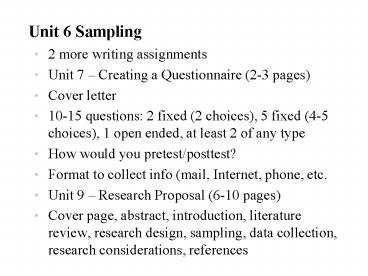Unit 6 Sampling - PowerPoint PPT Presentation
1 / 19
Title: Unit 6 Sampling
1
Unit 6 Sampling
- 2 more writing assignments
- Unit 7 Creating a Questionnaire (2-3 pages)
- Cover letter
- 10-15 questions 2 fixed (2 choices), 5 fixed
(4-5 choices), 1 open ended, at least 2 of any
type - How would you pretest/posttest?
- Format to collect info (mail, Internet, phone,
etc. - Unit 9 Research Proposal (6-10 pages)
- Cover page, abstract, introduction, literature
review, research design, sampling, data
collection, research considerations, references
2
Unit 6 Sampling
- Welcome Back !!!!
- Probability Samples
- Random
- Systematic
- Multi-cluster
- Probability Proportionate to Size
- Nonprobability Sampling
- Quota
- Snowball
- Purposive
- Convenience
3
Populations and Samples
- Population
- A complete set of individuals, objects, or
measurements having some common observable
characteristic. - Sample
- A subset of a population that is used to
represent the population.
Does Law enforcement deal primarily with
populations or samples?
Population
Sample
4
Probability Samples
- Probability sampling helps researchers and
practitioners generalize from observed cases to
unobserved ones. - Estimate error
- Representativeness
- Equal chance of selection
- Each member of a population has a known chance or
probability of being selected.
5
Probability Samples
- Probability Sampling
- Simple Random Sample
- Systematic
- Multistage Cluster
- Probability Proportion to Size
6
Simple Random Sample
- Assigning a single number to each element
in the population, and a table of random numbers
is used to select elements for the sample. Most
statistical programs have this function.
7
Systematic Sampling
Every Kth element in the total population
is chosen for inclusion in the sample. If a
population contains 300 cases and you want a
sample of 50, you select every sixth element
(300 / 50). The first case would be selected at
random to start the subsequent selection.
Random Start Every 6 selected
8
Multistage Cluster Sampling
- This is used when it is either impossible or
impractical to compile a sampling frame for an
entire population. Realistic subgroups are
identified to sample through random means. A GIS
is an invaluable tool for cluster sampling. - For example Identifying all residents of a
city (population) is not realistic. However, all
residents live in the city which can be broken
down into blocks or census block groups. After
conducting a random selection of block groups, a
particular number of houses in each can be
sampled randomly.
9
Select Random Block Groups
10
The Selected Block Group Contains Streets
11
The Streets Contains Residential Parcels
12
Ten Houses Selected Randomly
13
Probability Proportion to Size Sampling
- In the previous example, not all block groups
are the same size in number of houses. Thus, the
probability of one being selected changes by
block group. A resolution in this case is to
select a proportional number of households in
each block group.
14
Probability Proportion to Size
- Select a Block Group
15
Probability Proportion to Size
- Select a proportional number of households in
each block group.
16
Nonprobability Samples
- Nonprobability Sampling
- Quota
- Snowball
- Purposive
- Convenience
Nonprobability sampling does not allow for error
estimation and Representativeness can not be
assured.
17
Quota Sampling
- When a group has clearly defined categories of
participants, a researcher could use a quota
sample to be sure to select individuals in each
category. One begins with a matrix in which
relative proportion is assigned to each cell and
the researcher selects a sample of that
proportion from each category. Oftentimes, this
is used with many variables (Law enforcement
example white, male, more than 10 years on the
force, sergeant).
White Non-White
Males 40 15
Females 35 10
If the desired sample was 100, the researcher
would sample 15 nonwhite males and 40 white
males, and 10 nonwhite females and 35 white
females.
18
Snowball, Purposive Convenient
Snowball sample A sample in which each
participant interviewed or surveyed suggests
others to be participants. Examples Criminal
investigations, intelligence analysis. Purposive
sample A sample the researcher believes will
yield the most comprehensive understanding of the
subject of study. Examples Individuals who have
reported a crime to the police, minority
individuals receiving a traffic
ticket. Convenient sample Reliance on available
subjects. Examples Individuals on a street
corner, at a mall, university students, or
Internet users.
19
QUESTIONS ????
Questions? Be sure to complete DB, Get Write!
and quiz NO Unit 7 seminar next week !!!! Merry
Christmas and Happy New Year!!!!































